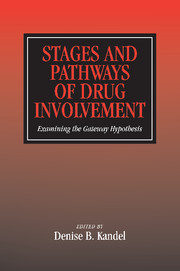Book contents
- Frontmatter
- Contents
- List of Contributors
- Foreword
- Preface
- Part I Overview
- Part II Recent Substantive Findings: What Do We Know About Stages of Drug Use, Risks, and Protective Factors?
- 2 Drug Sequences, Age of Onset, and Use Trajectories as Predictors of Drug Abuse/Dependence in Young Adulthood
- 3 Substance Use Norms and Transitions in Substance Use: Implications for the Gateway Hypothesis
- 4 Stages of Drug Involvement in the U.S. Population
- 5 Substance Use Progression and Hard Drug Use in Inner-City New York
- Part III Impact of Prevention Interventions: A Test of the Progression Hypothesis
- Part IV Methodological Issues and Approaches: Advantages and Limitations of Alternate Methods
- Part V Animal Models and Biological Processes: Implications for Drug Progression
- Part VI Conclusion
- Index
5 - Substance Use Progression and Hard Drug Use in Inner-City New York
Published online by Cambridge University Press: 25 July 2009
- Frontmatter
- Contents
- List of Contributors
- Foreword
- Preface
- Part I Overview
- Part II Recent Substantive Findings: What Do We Know About Stages of Drug Use, Risks, and Protective Factors?
- 2 Drug Sequences, Age of Onset, and Use Trajectories as Predictors of Drug Abuse/Dependence in Young Adulthood
- 3 Substance Use Norms and Transitions in Substance Use: Implications for the Gateway Hypothesis
- 4 Stages of Drug Involvement in the U.S. Population
- 5 Substance Use Progression and Hard Drug Use in Inner-City New York
- Part III Impact of Prevention Interventions: A Test of the Progression Hypothesis
- Part IV Methodological Issues and Approaches: Advantages and Limitations of Alternate Methods
- Part V Animal Models and Biological Processes: Implications for Drug Progression
- Part VI Conclusion
- Index
Summary
The Gateway Hypothesis holds that substance use typically follows a series of stages from nonuse of any substance as a child to use of alcohol and/or tobacco in early adolescence, potentially followed by use of marijuana and then hard drugs. Not all users of substances at one stage progress to the next. Most importantly, however, individuals who do not use substances at one stage rarely use any of the substances associated with later stages. This theory was first stated in its current form and supported by empirical evidence by Denise Kandel (1975) in the 1970s and has been confirmed widely since (as documented elsewhere in this volume).
It is quite remarkable that this simple sequence has so often emerged, given the wide variation in factors that have been found to affect youthful substance use. In particular, the attitudes, values, and opportunities available to youths have distinct roots that are historical, geographical, religious, and ethnocultural (Schulenberg, Maggs, & Hurrelman, 1997). Each individual's characteristics and family experiences have a role in defining her or his behavior within this larger context. Brown, Dolcini, & Leventhal (1997) describe how this person–context interaction may be reciprocal, particularly with regard to adolescent peer groups, further complicating matters. They found that youths both form or join groups partially based on common substance use patterns and that groups pressure individuals to use (or not use) various substances.
- Type
- Chapter
- Information
- Stages and Pathways of Drug InvolvementExamining the Gateway Hypothesis, pp. 90 - 112Publisher: Cambridge University PressPrint publication year: 2002
- 15
- Cited by



